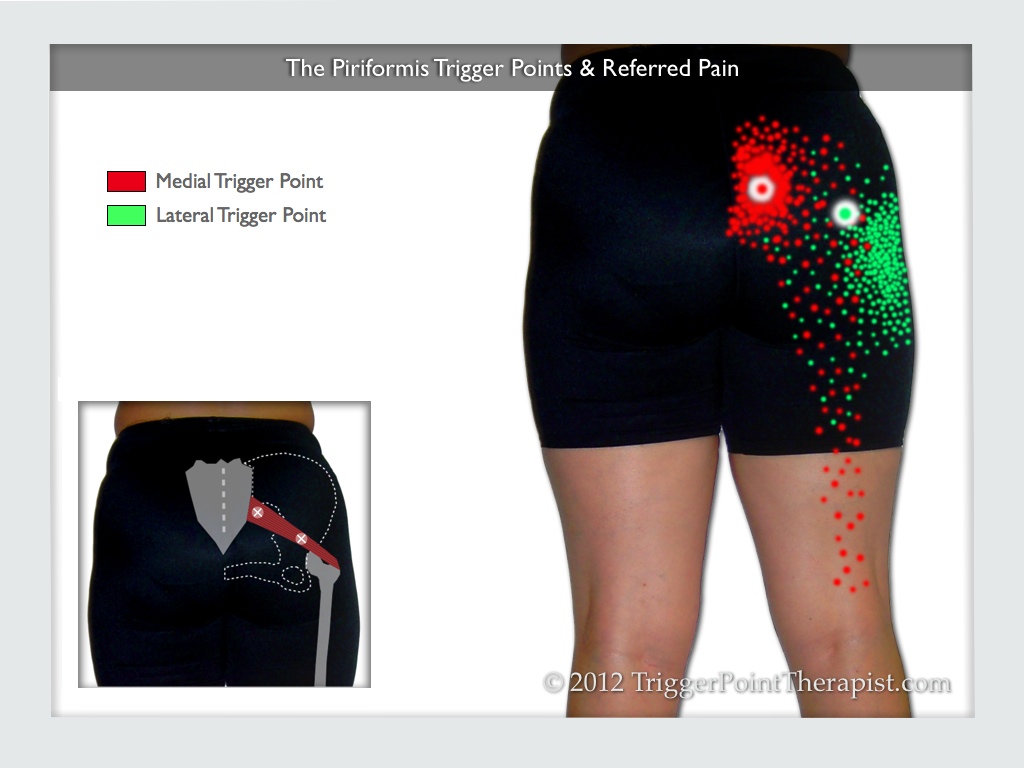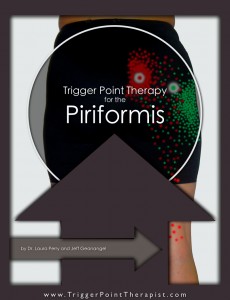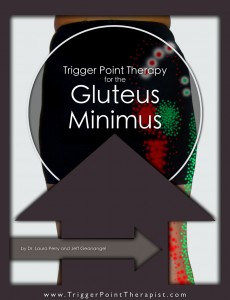Trigger points in the small piriformis muscle found deep in the buttock region can create an impressive amount of trouble for people. Active piriformis trigger points refer pain and tenderness to the sacroiliac joint, gluteal, and hip regions. They can also be responsible for a type of sciatica known as Piriformis Syndrome.
Piriformis syndrome occurs when a tense piriformis muscle entraps the sciatic nerve (and/or other nerves and blood vessels) as they exit the pelvis. Physical compression of the nerve causes neurogenic symptoms (such as burning pain, numbness, and tingling) to be experienced in the gluteal region and down the back of the legs.
Because of anatomical variations in the population, some people are more prone to developing Piriformis Syndrome than others. Referred pain from these trigger points is very common, however.
The Piriformis Muscle
Location: The piriformis is a small, thick muscle that lies deep in the buttock region, underneath the gluteal muscles.
Function: The primary function of the piriformis during everyday activity is to hold the articulating surfaces of the hip joint together during movements of the hip joint. It also functions to control the tendency of the thigh to medially rotate during walking and running.
Muscle Attachments: The piriformis muscle arises off the anterior (internal) surface of the sacrum and passes through the greater sciatic foramen to exit the pelvis laterally and attach to the greater trochanter of femur. Numerous nerves, including the sciatic nerve, and blood vessels exit the pelvis through the greater sciatic foramen with the piriformis.
The skeletal landmarks and muscular attachments of the piriformis muscle are shown in excerpt from the Trigger Point Therapy for the Piriformis Video Download at the end of this article.
Muscle Actions: Contraction of the piriformis muscle produces lateral rotation of the thigh at the hip, unless the thigh is flexed to 90° or more, in which case it becomes an abductor of the thigh.
The Piriformis Trigger Points
The piriformis may contain two trigger points, as detailed in diagram below.
- The medial trigger point lies an inch or so outside the edge of the sacrum, along the piriformis line.
- The lateral trigger point lies a few inches to the inside of the greater trochanter landmark, along the piriformis line.
Piriformis Pain
Piriformis trigger points can produce two types of pain; referred pain from the trigger points themselves, and the neurogenic pain that may result from a tense piriformis muscle entrapping the sciatic nerve as it exits the pelvis (a condition known as Piriformis Syndrome).
Piriformis Trigger Point Referred Pain
Typically, the medial trigger point refers pain to the sacroiliac joint region, while the lateral trigger point’s referral is concentrated in the posterior hip region (see diagram above). But it should be noted that both trigger points are capable of referring pain to all three referral regions (sacroiliac joint, posterior hip, and general buttock).
Piriformis Syndrome
Below is a basic explanation of Piriformis Syndrome as it relates to trigger point therapy:
- On its way to attach to the hip joint, the piriformis muscle passes through a short tunnel made of bone and ligaments called the greater sciatic foramen.
- Several nerves, and blood vessels, also pass through this tunnel as they travel from the spine to various regions of the lower trunk and body. The largest of these is the Sciatic nerve.
- The piriformis can vary in shape and size from person to person, and in some people a tense piriformis muscle can put physical pressure on the nerves and blood vessels as they pass through the tunnel. This is called nerve entrapment and it causes the nerve to not function correctly and to become a source of neurogenic pain.
- While many factors may cause the piriformis muscle to become enlarged, such as swelling from trauma, the most common cause is trigger point activity in the muscle. The piriformis trigger points cause the muscle to remain in a semi-contracted state, increasing the muscle’s girth and tension, causing it to entrap adjacent nerves in the tunnel over an extended period of time.
- Releasing active trigger points in the piriformis allows the muscle to assume a fully relaxed state once again, and relieves the pressure on the entrapped nerve(s) or vessel(s).
It should be emphasized that not every person has the potential to develop Piriformis Syndrome, whether they have piriformis trigger points or not. It all depends on their particular anatomy. In some (unfortunate) people, the Sciatic nerve passes directly through a bifurcation (split) in the piriformis muscle. In these cases, even latent piriformis trigger points can cause major trouble.
Piriformis Syndrome Symptoms & Disorders
The chief symptom associated with piriformis syndrome is sciatica. The term sciatica doesn’t describe a condition in itself, but rather a set of symptoms that may be produced by several different conditions. This set of symptoms is described as pain that radiates from the buttocks, down the back of thigh, and into the lower leg and foot. It may also include parethesia-type symptoms such as numbness, tingling, and burning sensations.
Typically, sciatica symptoms are attributed to a spinal disc rupture or protrusion in the lumbar spine that compresses the spinal nerve roots (called lumbar radiculopathy). Several studies suggest that 40-50% of sciatica cases may actually be the result of piriformis syndrome, and not radiculopathy.
In my own clinical experience I have found piriformis syndrome to be the cause of sciatica symptoms in 30% of cases involving males, and in over 70% of the cases involving females.
Though the sciatic nerve is the largest nerve in the region, and therefore most often involved in piriformis syndrome, there are several other nerves and vessels that can be entrapped by a tight piriformis muscle:
- The superior gluteal nerve and blood vessels (which supply and control the tensor fascia latae, gluteus medius, and gluteus minimus muscles)
- The pudendal nerve and blood vessels (which innervate the muscles and skin in the genitalia and anal regions)
- The inferior gluteal nerve (which controls the gluteus maximus muscle)
A person with piriformis syndrome can have any or all of the following symptoms:
- Pain, numbness, burning, or tingling in the buttocks, that may radiate down the back of the thigh into the calf and foot regions.
- Pain and symptoms are aggravated by sitting, particularly sitting with the one leg crossed over the other.
- Pain in the rectum during a bowel movement
- Sexual dysfunction, including impotence in males and painful intercourse for females.
- Swelling in the leg on the painful side
- Groin pain in the inguinal region
- Limp
Piriformis Trigger Point Symptoms
A person with active piriformis trigger points may or may not have the symptoms of piriformis syndrome listed above. Some of the symptoms associated with piriformis trigger points (alone) include:
- Sacroiliac (S.I.) joint pain and dysfunction
- Posterior hip pain
- Gluteal or buttock pain that may extend down into the upper posterior thigh region.
What Causes Piriformis Trigger Points?
The following events or activities may activate or reactivate the piriformis trigger points:
- True Sacroiliac Joint Dysfunction
- Sudden foot slip
- Twisting sideways while bending and lifting
- Running
- Sexual positioning
- Impact trauma
- Automobile accident
- Chronic Pelvic Inflammatory Disease
- Hip Replacement
Treatment of Piriformis Trigger Points
Piriformis trigger points rarely occur in isolation, and nearly always show up as a component of more complex (chronic) low back pain and hip pain complaints. For this reason, therapists who attempt to treat these trigger points in isolation are likely to get mixed (or short-term) results. If the client has a sciatica component in their pain presentation, I strongly encourage the therapist to use the Low Back Pain & Sciatica Protocol for best results.
For more information on these trigger points, as well as step-by-step instructions for locating and releasing them, please purchase the Trigger Point Therapy for the Piriformis Video Download or the Trigger Point Therapy for the Piriformis Booklet for the iPad.
Click on the image below to watch an excerpt from the Piriformis Trigger Points video on YouTube:
Related Articles:
- The Quadratus Lumborum Trigger Points: Masters of Low Back Pain
- Gluteus Minimus Trigger Points: A Small Muscle With A Big Mouth
- Trigger Point Therapy for Low Back Pain; Understanding the Complaint Within the Complaint
Related Instructional Videos:




